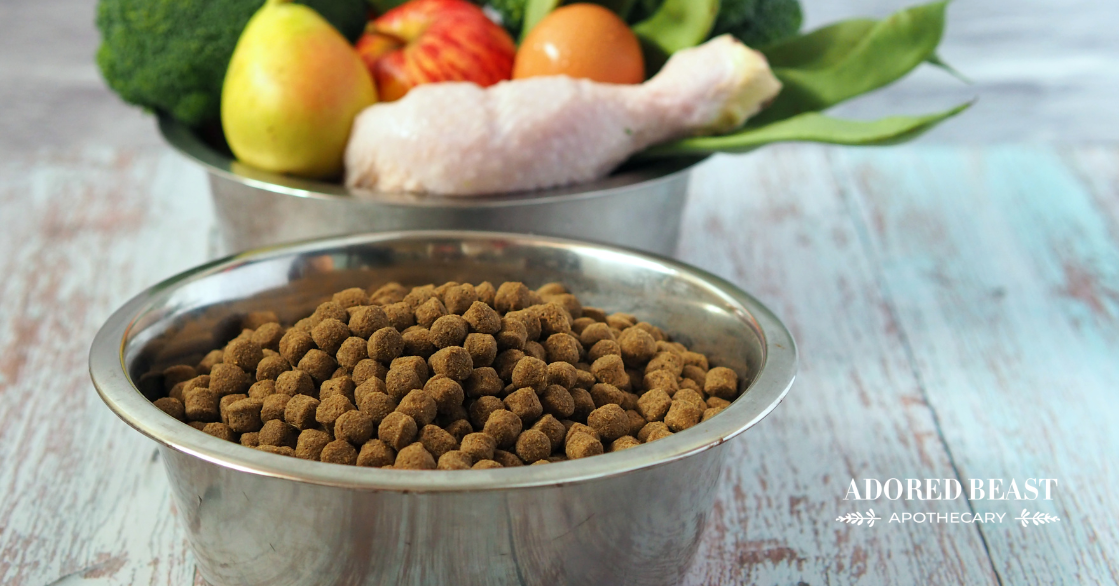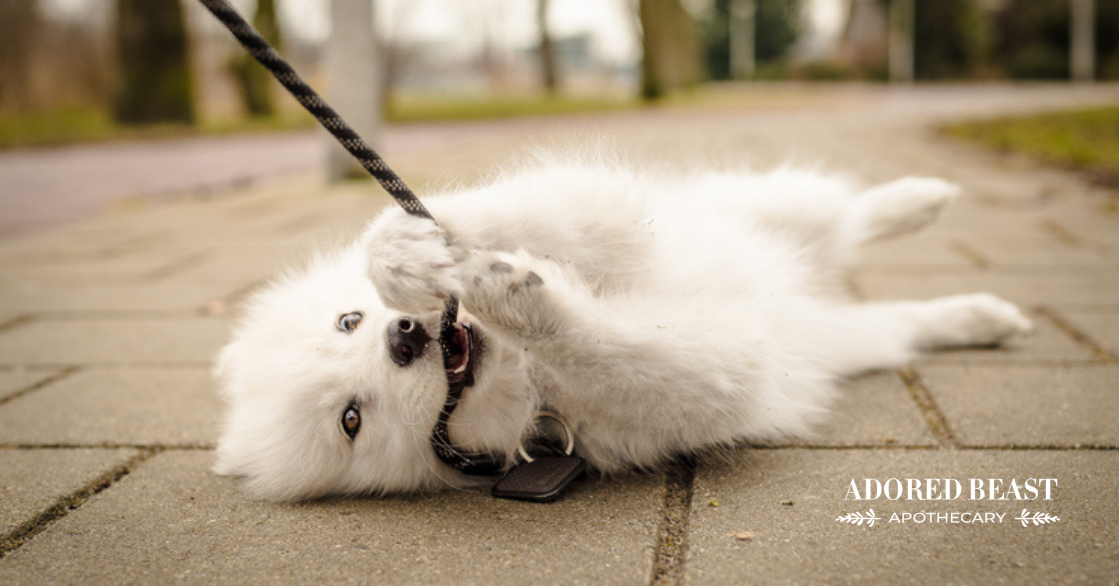As pet parents, we all choose to feed our animals what we do for a reason.
Maybe you’ve made the choice based on research.
Perhaps your pet has a health condition and your vet has recommended a specific food.
Maybe your animal is picky and the food you feed is chosen based on what they will eat.
Perhaps the reason is financial or made because of time constraints.
Or maybe you’ve just always fed what you feed now and have never had any issues.
In many cases, the chosen food is kibble. Although we will always recommend fresh, whole food, we recognize that everyone feeds what they do for a reason.
The great thing about kibble is, there are many ways to make it better! There is a wide variety of things you can add, from fresh food to supplements, to boost the nutritive value and digestibility of cat and dog kibble!
And yes, even raw feeders can add things to their animals’ diets for added value!
How to Make Cat and Dog Kibble Healthier
Because of the way that most kibbles are manufactured, using high heat and heavy processing, many nutrients, if not most, are lost in the cooking process. It’s always nice to be able to add nutrients to the bowl so your animal is not missing out!
Digestive Enzymes
One of the absolute best things you can add to kibble is digestive enzymes. Digestive enzymes are compounds that aid digestion by helping break down food molecules into smaller pieces. The body makes them naturally, and they come from food/supplements.
How can they make cat and dog kibble healthier? Well, thanks to the processing and high temps we mentioned, kibble tends to have low bioavailability. That’s the rate at which the body can absorb and use something – in this case, nutrients. One of the ways to measure it is by how well the nutrient in question is stored or available with respect to its ability to support your pet’s physiology.
So low availability means your dog or cat can’t absorb or take advantage of the healthy stuff in the kibble very well.
By breaking down the food into smaller pieces, digestive enzymes can help improve bioavailability. In fact, they can make kibble up to 65% more bioavailable!
What’s more, the high temperature cooking process can destroy virtually all enzymes that exist in a food, which means very little pre-digestion takes place in the stomach. Instead, food enters the small intestine largely undigested, which puts major stress on the pancreas and other organs to produce massive amounts of the proper enzymes. That’s never good for the body.
So, even if you don’t add anything else to the bowl, digestive enzymes alone can help make kibble healthier.
Note: Even raw fed animals can benefit from digestive enzymes! Well-balanced, species-appropriate raw food is better than kibble as far as enzyme content, but things like vaccines, pharmaceutical drugs, even fluoridated water can all impact your pet’s ability to produce enzymes naturally. Also, if your raw food doesn’t have the beneficial organs (ex. the pancreas, gallbladder, glands in the intestinal wall) an animal would find in whole prey, they could be lacking!
Fruits and Vegetables
There are lots of different fresh foods you can add to your animal’s dinner to make cat or dog kibble healthier. And fruits and vegetables are a great option.
Rotational feeding of fruit and vegetables is one of the easiest ways to get a variety of nutrients into your dog, everything from vitamins and minerals, to fibre, to valuable antioxidants and polyphenols. They also help provide variety, something kibble-fed pets are often lacking.
Some to consider rotating in are:
- Broccoli
- Cauliflower
- Microgreens
- Sprouts
- Cucumber
- Spinach
- Kale
- Beets
- Carrots
- Yams
- Berries
- Apples
- Bananas
- Watermelon
Note: You may have heard that carrots, beets, yams and other roots can be high is sugar but when fed in a raw/blended format, they actually contain beneficial fibres that counter-act glucose uptake!
**Most cats won’t eat fruits and vegetables, and that’s ok! Let’s be honest, most cats will only eat what they want to eat. These are great for your dog though!
Eggs
Many people believe (and many studies show) that eggs are one of the most densely healthful foods on the planet because of the vast amount of nutrients they offer. Protein, fat, omega 3s, taurine, vitamins, iron, zinc – all in one perfect little package. The list of documented health benefits from eggs is equally impressive. Studies have shown how adding eggs into a balanced diet can benefit joint health, eye health, cognitive health, and heart health in all mammals.
Raw eggs, WITH the eggshell membrane, are especially great for joint health. Eggshell membranes (that’s the lining of the eggshell) is a natural source of collagen, glucosamine, chondroitin, hyaluronic acid, and calcium – nutrients that are essential for maintaining healthy joints.
Bone Broth
Bone broth for pets is a superfood that’s really easy – and inexpensive – to make! It’s full of vitamins and minerals like iron, vitamins A and K, fatty acids, selenium, zinc, and manganese.
But that’s not all. Bone broth:
- Is ideal for animals feeling a little under the weather – it’s gentle, yet super nutritious. It increases fluid consumption and offers much-needed nutrients at a time when your pet needs a boost.
- Helps maintain gut health, especially for pets with digestive issues – some amino acids in bone broth, particularly one called glutamine, have serious potential for improving digestion.
- Is great for supporting joint health. The collagen from the bones is incredible and bone broth is a natural source of glucosamine-chondroitin that’s proven to help keep cartilage healthy and can even help relieve joint pain.
Another nice thing about bone broth is that you can choose what else to add to it. Want to boost the flavour for picky eaters? Add a little liver. Want some extra inflammation fighting power? A little turmeric will do the trick. You can even add veggies or pet-friendly herbs for added nutrition. The sky’s the limit, seriously. Plus, it adds some much needed moisture to both cat and dog kibble, which is very important!
Raw Goat’s Milk
We really like raw goat’s milk as an addition for a number of reasons.
- It contains proteins, fats, enzymes, probiotics, vitamins, minerals and more!
- It adds moisture, which is so crucial for kibble-fed animals.
- Energetically, kibble-fed animals tend to run warmer, and goat’s milk can help take away some of that internal heat!
Worried about digestibility? Many pet parents don’t like the idea of milk because of concerns regarding digestibility. And that is valid when it comes to cow’s milk – cow’s milk is not easy to digest. But goat’s milk is much easier due to its smaller protein and fat molecules so it doesn’t produce the phlegm that cow’s milk can. Even dogs who tend to be sensitive to cow’s milk typically have no issues at all with goat’s milk.
Organ Meats
While adding organ meats might make you a little squeamish, they do have a lot of value. If you feed raw, you likely already feed organs, but you can always add more variety!
Here’s what they bring to the table:
- CoQ10, which is vital for energy production and cardiac function, as well as a potent antioxidant
- B complex vitamins, including B12 and folate
- Minerals, including iron that’s easy to absorb, as well as copper, zinc, and chromium
- Quality fats
- Excellent protein
- Choline, another B vitamin, important for cell membranes, brain and nerve function, heart health and prevention of birth defects
- Collagen, which is vital for skin elasticity and health, is paramount in the health and strength of ligaments. It’s the substance that holds and weaves the entire body together, providing its strength and structure
- Vitamin E, for circulation, tissue repair, healing, deactivation of free radicals, slows aging
- Vitamin K2
- Amino acids
- Elastin,the protein that gives the skin the ability to stretch and bounce back
- Keratin, a fibrous structural protein that protects epithelial cells from damage or stress
You can rotate through any of these:
- skin
- eyeballs
- testicles
- feet
- beaks
- hooves
- feathers
- hair
- thymus
- uterus
- penises
- green tripe
A few tips:
- A little goes a long way. Start introducing them very slowly. Organs can be very rich, and can take some getting used to.
- Organ meats should not make up more than 10% of the total diet.
- Source carefully – try to find organs that come from pasture-raised, grass-fed/finished, hormone, pesticide and GMO free animals.
- If using a supplement, be sure to source undefatted options that are 100% freeze-dried, and again, from pasture-raised, grass-fed/finished, hormone, pesticide and GMO free animals. Make sure they contain no fillers or flow agents of any kind.
Complimentary Foods
What’s really cool about adding fresh food to the diet is that, when certain foods come together, not only can they complement each other, but they can also boost their individual health benefits.
For example, healthy fats like hemp seeds, whole eggs, fatty fish, whole raw milk or cheese and small amounts of avocados support the bioavailability of certain vitamins:
- Vitamin A: in carrots, pumpkin, winter squash, dark green leafy vegetables and apricots, all rich in betacarotene
- Vitamin D: in raw milk and other fermented dairy products, oily fish like herring, salmon and sardines, or cod liver oil
- Vitamin E: in fruits and vegetables, oats, almonds, hazelnuts, sunflower seeds
- Vitamin K: in green leafy vegetables, turnip greens, spinach, cauliflower, cabbage and broccoli, hemp oil, olive oil, meat in general but especially liver.
So adding a whole egg to your animal’s bowl helps with the bioavailability of vitamin A from all of the dark leafy greens, or vitamin E in the fruit, or vitamin K from liver… and so on.
And, certain foods help with digestive enzyme production, and feeding enzyme-rich foods can help build up the stores in your pet’s body. These include:
- Fermented vegetables
- Raw kefir
- Certain fruits – kiwi, papaya, banana, mango, pineapple
- Raw apple cider vinegar
- Ginger
- Raw honey
- Organ meat
**A note on fruits and vegetables. Go for local, and rotate fruits and veggies that have a seasonal flair. Talk to local farmers in your area, or at farmers’ markets, and play around with different things. This can really help widen the nutritional profile and increase vitality.
No matter what you feed, adding fresh food to the bowl has a wealth of value for the health and wellness of our animals. Just as we try to eat a variety of fresh foods each day, so too should our pets. Rotate through the things on this list and your pet will never get bored! Adding a little of something different each day is the perfect way to help make cat and dog kibble healthier, and have a little fun along the way.












![[RESEARCH] Is Herbicide Safe for Dogs?](https://blog.adoredbeast.com/wp-content/uploads/2025/06/herbicides-safe-for-dogs-103x55.png)